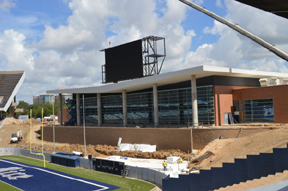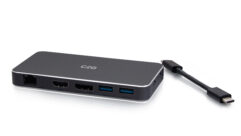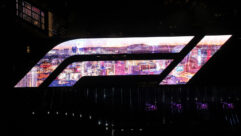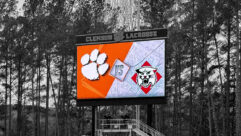
SVC Podcast – Show Notes – Show 157-1
In this edition of the SVC Podcast, SVC Contributing Editor Bennett Liles talks with Dan Fjeldheim of Daktronics about the new 29ft. by 49ft. LED video display board being installed at the renovated football stadium at Rice University in Houston, Texas. Dan discusses the technology behind the new video board and he details the installation of the acoustically transparent audio facades on each side of the main display.
For Part 2
Links of interest:
- Daktronics, a leading manufacturer of outdoor LED video displays
- Daktronics YouTube Support Channel
- Press release on the new video display board installation at Rice Stadium
Download Podcast Here:
https://s3.amazonaws.com/nb-svc/public/public/157-1_Daktronics_Rice_1_0.mp3
From Sound & Video Contractor Magazine, this is the SVC Podcast with Dan Fjeldheim of Daktronics. Show notes and equipment links for the podcast are on the web site of Sound & Video Contractor Magazine at svconline.com.
As part of the renovation of the Rice University football stadium in Houston, a huge new LED video display board from Daktronics is rising above the field. The new board will have audio facades on both sides that will stretch the overall size to 29 feet by 69 feet. Dan Fjeldheim of Daktronics is going to give us the story behind the huge project to get it up and running by game time this year. That’s coming up right now on the SVC Podcast.
Dan, so glad to have you here with us on the SVC Podcast from Daktronics and we’re going to be exploring the installation of the huge new LED video display board at the Rice University football stadium in Houston. This one is going on right now as we’re recording this so it’s great to have you here to tell us about it.
I appreciate the opportunity, Bennett. Rice University Football Stadium is a nice project going on for us right now. Happy to visit with you about it and kind of let everybody know what’s going on there. [Timestamp: 1:15]
So how did the new video display project come about? This is actually part of a much larger renovation for the stadium, isn’t it?
Yeah, correct. About four or five years ago they had a vision to redo part of the stadium in regards to their training rooms, their locker rooms, their sports medicine facilities. So the old video display was at the south end of the stadium and that’s kind of where they had pegged to put this new building up. So as part of the construction of this new building they had to do some demolition on that south end of the stadium and that obviously made the existing scoreboard go away so they could have a footprint to build this new facility. So they broke ground on that, actually it was last summer. They actually went the 2015 season without a video display as they did construction for this new facility down at the south end zone. But as part of that, they realized that they wanted to put the video display back up in that south end. So what they did as part of the new building was build a structure to go up over the top of that building that would support this new video display that we’re currently installing. [Timestamp: 2:28]
And one of the more interesting things about this is the LED technology that’s going into it. What size are the main screen and the audio facades planned to be?
Sure, Bennett. In the middle 29 feet by 49 feet tall will be their main primary video display. And that will be with our 13HD Technology. The 13HD is the benchmark standard in our industry when it comes to clarity and color depth and brightness. To give you an example, the 13HD has been installed in Jacksonville at that Jaguars Stadium when those boards when in. They are still the largest video displays in the world. The Cleveland Indians also debuted their 13HD products for the largest display in major league baseball. And on the collegiate level, Auburn University also has the largest video display with our 13HD products. So Rice didn’t cut any corners when it came to going with the best product that was available on the market today with our 13HD. One the sides of the videoboard are the sound cabinets. Those are 10 foot wide by 29 foot tall. So they’re the same height as the actual main video display. And so those sound cabinets are covered with our Daktronics LED audio façade product. We did a lot of testing to figure out how could we put LED’s in front of speaker mesh that typically is just an acoustically transparent material. So we found how we could space out LED’s to where there would still be a visible and readable image yet it wouldn’t affect the sound quality coming out of the speakers behind it. So through some testing and experimentation we found a good happy medium there that didn’t affect the audio coming out of those sound cabinets. And so this LED audio façade product is fairly new. It came out here about a year or so ago and Rice will be only the second collegiate football stadium to have this product. So pretty cutting-edge product and really excited about the opportunity to showcase this down in Houston. [Timestamp: 4:30]
What’s really special to me is how you would test the facades for audio transparency and changing the spacing of the LED assemblies. How you do that could be a whole story in itself.
The LED’s themselves, their basically on LED sticks, so they’re about two-inch wide sticks. And so what we did is we kind of spaced those sticks. We spaced them two inches apart, three inches apart, once inch apart. Just kind of did some experimentation on that. And we got to a point where roughly about two inches of spacing for each of those two-inch sticks was a good enough image yet didn’t affect the sound quality. So what we did is during Rice’s process of what they were going to look at purchasing, we brought down a demonstration unit that had speakers behind it with the actual LED façade on it so they were able to hear that and see that it didn’t affect the audio even though they had those LED’s in front of there. [Timestamp: 5:24]
And as you mentioned, this is all part of a bigger project of renovating the Rice University stadium. It appears that the new LED video display board is on top of a building. Are there special precautions or special techniques involved in putting it up there?
Because they were building the building below it, we had to work with the general contractor as far as the schedule of when we could install the displays. They did a majority of the building work first. Obviously they had to get the infrastructure up and the roof in place and those type of things before we went up there and started hanging our displays. So the video displays themselves being installed here as we speak are towards the end of the actual project – one of the last phases of the project that got work going on inside of the new facility but as far as the exterior and the things they’re doing to the outside, our piece was pretty late in the project just because they had to get all that stuff in place first. [Timestamp: 6:21]
Well, you obviously can’t change the direction the stadium faces so does the direction that the display is facing require any kind of special consideration as to the sun angle or how it’s going to look at a certain time of day and time of the year when these games are likely to be played?
Yeah, it does. It really does, Bennett. One of the things we did is we brought a sample unit down to show them and faced it similar to the direction that this videoboard would be facing. We looked at it when it was in direct sunlight and one of the things that they acknowledged is we have some later afternoon/early evening games with that direct sunlight shining right on the video display we needed to make sure that we had the brightest product possible in order to combat that direct sunlight. So our 13HD product that we talked about a little bit earlier has very good brightness and can fight through that direct sunlight so that image doesn’t look washed out. [Timestamp: 7:17]
Since this is a part of a bigger renovation project, did you use the existing cabling? It sounds to me as though you had to run new conduit and cabling and everything.
The conduit and cabling obviously run all the way up to the press box, but they also did some new locations where they were going to control their scoreboards and house their production equipment and all the Daktronics computers and software. So there was new cabling run. We utilized a bit of the existing conduit from the press box down to a certain location, but we kind of tied it off there and had to start new so it was a combination of new and old. [Timestamp: 7:52]
And since the video display was put in sort of late in the construction and there’s always a challenge in having so many tradespeople working in close proximity. A major part of the planning is just in keeping people out of each other’s way.
We had weekly coordination meetings with the general contractor. A company called Anslow Bryant was the GC on the project. So we needed to coordinate with them very closely as far as what work we would be doing, when we would be doing it and making sure we weren’t stepping on the toes of anybody else that was trying to get work done on the building. [Timestamp: 8:25]
Always a little bit of a six-handed game when you have that many people involved. So when you get this video display set up and it’s operational, how do you do the final test and who does the testing?
It kind of goes in a couple of different phases. The first phase is obviously to get the board physically in place. It comes in roughly 7 foot tall by 9 foot wide sections. So the video display itself of this size would be roughly about 20 sections of that display. And then from there, once those all get physically mounted and attached in place to the steel, then we come in with the electrical work and get the fiber optics and the signal cable connected. And then the last piece of it is to power, to get the electricity to it. So once those phases are all done we turn it on, get the computers wired up and then there is a testing phase just to make sure everything is working right and the electricity is flowing properly. [Timestamp: 9:23]
I guess that’s the “Wow” phase of it when you put the programming to work and see the moving images and the part that really gets the crowd’s attention.
Yeah. In the initial testing we’ll do some colors. We’ll go through a red, blue, green, white color wash with the LED’s – what we call burn in. Sometimes they take a few days to kind of get up to their full capacity and capability. So there is some initial color testing and then once we do that we start to program the board. These video displays can be one giant monitor or just like you’re watching your TV at home, but they can also be sectioned off or divvied up into different areas of the board where one area might show statistics, one area might show sponsors. One area may show the time and score and game in progress information. So you’ve got some programming that needs to be done while we’re getting the board physically fired up with the LED’s itself, on the back end the guys are starting to do some of the programming work. So when that’s all ready to go then we actually send those images out to the board, see how it looks and tweak it a little bit to their liking. So there is kind of a physical, I guess, testing with it and then there’s also the computer programming side of it as well. [Timestamp: 10:39]
Well, I know it’s great when you get it fully operational and you get to fire it up and see what it can really do. I really appreciate your giving us the story on this and in Part 2 we’ll get into more about the installation and testing. It’s Dan Fjeldheim from Daktronics and the new LED video display in the Rice University football stadium. It’s nice having you here, Dan.
I appreciate it, Bennett. Thank you, sir.
Thanks for joining us for the SVC Podcast with Dan Fjeldheim. Show notes and equipment links are on the website of Sound & Video Contractor Magazine at svconline.com. Next week in Part 2 Dan will get into the details of how the big LED video display at Rice Stadium is fastened together and wired for operation. That’s on the next SVC Podcast.










